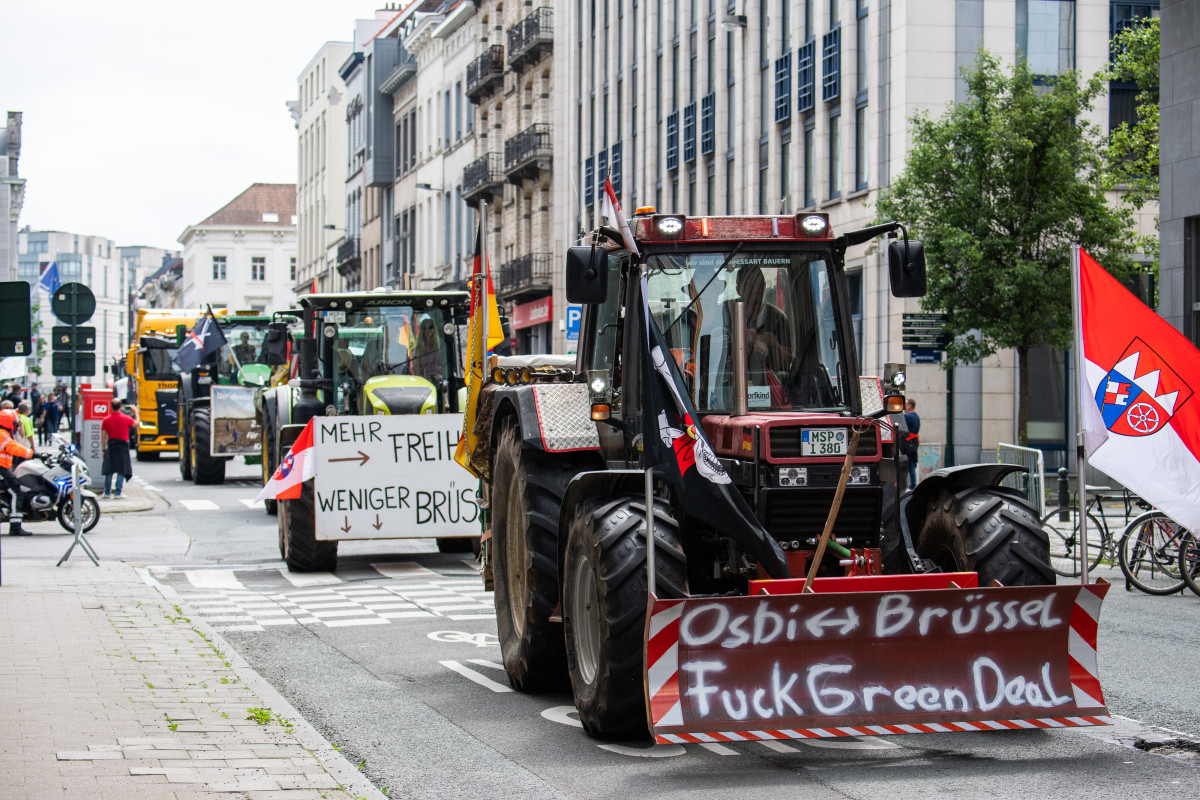Q&A: What is on the menu of the EU’s new Vision for Agriculture and Food?
What is the Vision for Agriculture and Food proposed by the EU?
The EU’s Vision for Agriculture and Food, published on 19 February, can be seen as a blueprint that lays the groundwork for the direction of European agricultural and food policy over the next five years and beyond towards 2040. Christophe Hansen, recently appointed as the agriculture commissioner, described the Vision as a “shared roadmap for future initiatives”.
A brainchild of Commission president von der Leyen, the new roadmap was built on the recommendations of the Strategic Dialogue on the Future of Agriculture, a multistakeholder forum launched in January 2024 (See the question below for more details on the dialogue).
As set out in commissioner Hansen’s mission letter, the Vision was presented in the first 100 days of the new administration's time in office as part of efforts to ensure the “long-term competitiveness and sustainability of our farming and food sector within the boundaries of our planet.”
How is the Vision relevant?
First and foremost, the Vision will guide all future thinking on agrifood policy. It will essentially replace the Farm to Fork strategy – the previous administration’s flagship agrifood policy and part of the Green Deal policy package – in helping to reconcile green goals with the economic realities of farming.
The Vision will play a key role in dictating how the Common Agricultural Policy (CAP), the EU’s farming subsidy programme, looks after the current iteration runs out in 2027. Currently worth a third of the EU budget, the CAP is renegotiated every 7 years, with talks opening years ahead of the deadline. In the summer, the Commission is due to present a proposal for how the CAP might look in the future.
With a 2030 deadline looming for many of the EU’s green targets, the next five years will decide whether the EU will achieve the targets set out in its Green Deal policy programme. The European agricultural sector is responsible for 12 percent of the EU's total greenhouse gas emissions and also a key driver of biodiversity loss, so getting farmers on board is vital if the EU wants to stand a chance of achieving its green goals.
. An employee harvesting peppers in the greenhouse at Westhof Bio farm in Wöhrden, Germany. Source: European Union/Frank Molter.](https://www.cleanenergywire.org/sites/default/files/styles/paragraph_text_image/public/paragraphs/images/european-union-frank-molter-peppers-harvest-greenhouse-germany-woehrden-westhof-bio-2017.jpg?itok=dACLkhO1)
However, that is easier said than done. EU farmers are still reeling from the double whammy of the COVID pandemic followed immediately by Russia’s invasion of Ukraine, leaving them squeezed between rising costs and falling prices. Farmers are becoming more frustrated with what they describe as the EU’s escalating environmental requirements and bureaucratic burden, coupled with concerns over their weak bargaining position in the food supply chain.
These escalating tensions drove EU farmers to the streets in protest at the beginning of 2024, and while tensions have calmed for now, they are still simmering close to the surface. Against this backdrop, the Vision is a key part of ongoing efforts to temper increasing polarisation in the agrifood sector by offering farmers a clear path forward.
How did the Vision come about?
The European Commission announced in September 2023 that it would launch a strategic dialogue on the future of agriculture. The dialogue group consisted of 29 agrifood stakeholders from all sides of the supply chain, including farmers’ groups, civil society and industry.
The idea was to get stakeholders in the agricultural supply chain – everyone from producers and processors, through to NGOs and industry – around one table to find compromises in an effort to foster “more dialogue and less polarisation” in the sector.
The dialogue centred around several core questions, chief among them how to guarantee a fair standard of living for farmers while also ensuring the sector fits within planetary boundaries. The group examined ways to maximise the potential of technological innovations, ways to lighten the bureaucratic load on farmers and ways to make the sector more competitive. The latter two points will be defining themes of the new Commission over the next five years.
The dialogue was guided by an independent chair, German researcher Peter Strohschneider, and conducted in secret to encourage open discussion. The group met regularly over a period of seven months to discuss their differences and write a shared report on the future prospects of the sector.
Political pressure mounted on the talks as they fell squarely in the middle of the farmers’ protests in January 2024, further adding to the challenge.
Against the odds, the group published their joint report in September and presented an assessment of the challenges and opportunities facing the sector, as well as a set of policy recommendations. These recommendations are set to form the basis of the upcoming Vision.
What are key proposals in the Vision?
The Vision is orientated around four fundamental priority areas. These include focusing on creating an agrifood sector that is: “attractive and predictable” with incomes that enable farmers to thrive; “competitive and resilient” in the face of rising global competition and shocks; “future-proof” and functioning within planetary boundaries; and lastly one which “values food, fair working and living conditions”, as well as “vibrant and well-connected rural and coastal areas”.
The Vision charts a new policy course away from the Farm to Fork policy, the agrifood part of the EU Green Deal which helped shape policy over the past mandate. It places a stronger emphasis on economic sustainability rather than environmental, as well as a core focus on resilience, security, simplification and competitiveness.
Plans for the EU’s farming subsidy programme can be described as evolutionary, rather than revolutionary. It may stop short of getting rid of area-based payments altogether, but it does set out plans to redirect EU farming subsidies towards farmers that “need it most”, with particular focus on young farmers and smaller family farms. Meanwhile, the general focus has switched from stick to carrot, meaning we can expect the next CAP to be incentives-based rather than prescriptive, and from green to lean. This means streamlining the EU’s farming subsidy programme, with a new bureaucracy simplification package promised in the coming months in efforts to cut red tape.
The Vision has a strong focus on generational renewal, with a new strategy promised to explore ways to encourage young farmers to enter into the profession, and on strengthening the economic viability of farming. This includes plans to ensure that farmers are not forced to sell below production costs, doubling down on previous promises to review the EU’s unfair trading practices directive. It also leans heavily on complementary income sources for farmers, including solar, biogas, carbon farming and the development of nature credits.
This will be combined with efforts to “leverage and de-risk private capital”, promising to work closely with “institutional investors” such as the EIB as well as the banking sector. However, it failed to address rumours that the CAP budget will be merged with other funds into one big money pot, hinting only that there should be more “synergies” between funds.
On pesticides, the agriculture Commissioner made it clear that he will not put its contentious plan to slash pesticide use back on the table. Instead, the focus will be on accelerating market access for alternatives, such as biopesticides.
The Vision also envisages a tougher trade stance, such as a stronger alignment of production standards applied to imported products, notably on pesticides and animal welfare. This includes, for example, not allowing the hazardous pesticides banned in the EU to be reimported back through imported products.
Overall, the Vision is shorter sighted on the ‘food’ side of the food chain than on ‘farming’, something that stakeholders were quick to criticise (see below for more reactions). A few standout ideas include a new proposal on public procurement and on origin labelling. Front-of-pack nutritional labelling plans set out in the Farm to Fork have been dropped, while there is nothing concrete on tightening advertising standards.
How did stakeholders react?
The Vision has been met with mixed reactions, with most agreeing that the new blueprint was nothing visionary.
For EU farmers’ association Copa-Cogeca, the Vision is a “pragmatic reset” which speaks a “different” language. However, it criticised its failure to address what it called the “elephant in the room”; the need for a robust future CAP budget and adequate resources to finance this package of measures. Likewise, EU young farmers’ association CEJA generally welcomed the strategy as a “constructive approach”, but criticised its lack of specificity. On the other hand, small farmers association European Coordination Via Campesina warned that the Vision was full of “deep contractions” and not ambitious enough to rise to the challenges faced by the sector.
Green groups were quick to denounce the Vision for its shortsightedness. For example, Birdlife Europe warned that it “largely maintains the status quo,” maintaining that it “fails to propose concrete policy actions to tackle the ongoing climate, biodiversity, and social crises”. Likewise, the European Environmental Bureau said the announced plans lack vision and fall “well short” of the bold measures agreed in the strategic dialogue, of which both NGOs were participants.
Meanwhile, industry group FoodDrinkEurope, representing the European food and drink industry, said the roadmap “falls short where it matters most” – namely, that it remains “overwhelmingly focused on farming, offering little in the way of concrete measures to support Europe’s food and drink enterprises”. Likewise, the European Consumer Organisation BEUC said the Vision was a “missed opportunity” to bring the EU closer to consumers.
What does this mean for the future of agricultural policy?
The first thing to note is that this Vision officially closes the Farm to Fork chapter for the agrifood sector. Asked during a press conference at the launch of the Vision whether this sounds the death knell for the green policy, the EU’s agriculture Commissioner said that the way of working has “clearly changed towards those reductions that are needed”, stressing the need to “depolarise” the debate. Translation: agrifood policy is in newer, but not necessarily greener, pastures.
Alongside the publication of the Vision, the Commission is turning the strategic dialogue group into a permanent advisory body called the European Board on Agriculture and Food (EBAF). The board is charged with providing high-level advice to the Commission on work following the report and helping to develop the Vision.
The hope is to sustain a “new culture of dialogue, trust and multi-stakeholder participation” among the actors of the food supply chain and civil society, as well as with the Commission. The EBAF has already had its first meeting, and will continue to regularly meet over the course of this next 5-year political cycle.
The way that the Commission enacts this new policy blueprint will have far-reaching consequences for the future of the sector. Not only could decisions impact how farmers view the EU, they could also affect whether the bloc meets its environmental targets and test the tentative trust the Commission has tried so hard to cultivate with the agrifood community, particularly in the aftermath of the Mercosur trade deal.
Going forward, the Vision will be a litmus test for the success of the strategic dialogue and whether that is a policy tool that can be leveraged elsewhere in the Commission. The Commission has already announced similar dialogues in other sectors, signalling that this could be an important tool for policy making in the future, and that means it is worth paying attention to the way this process unfolds.


